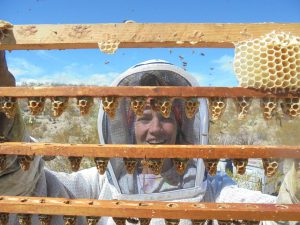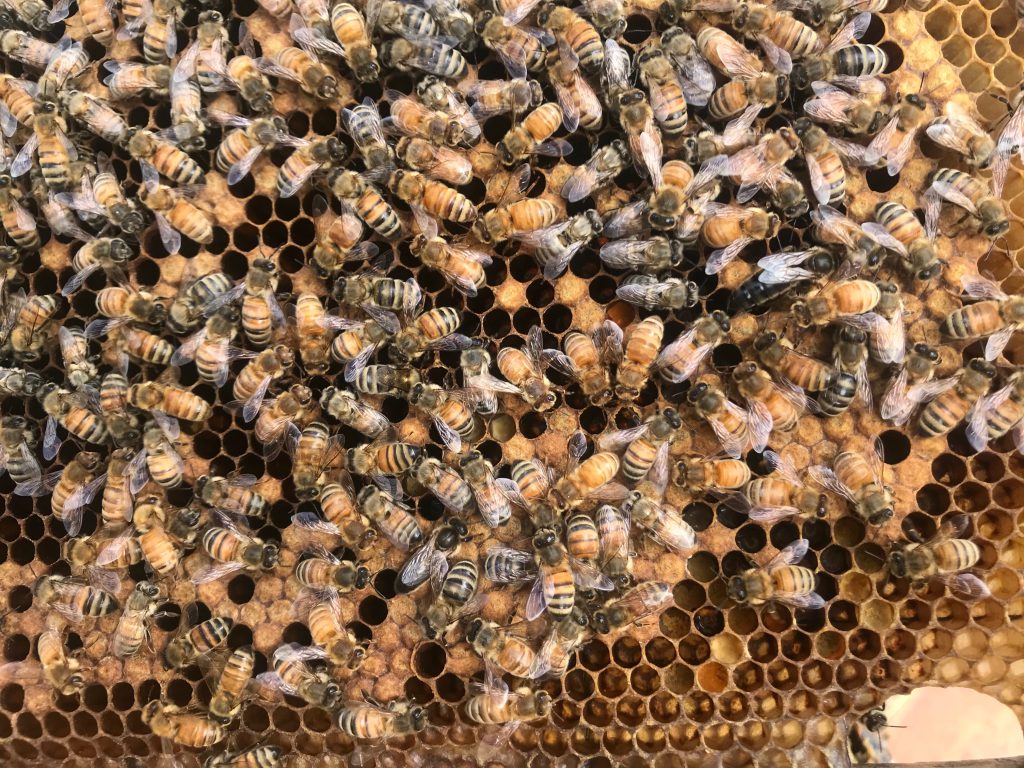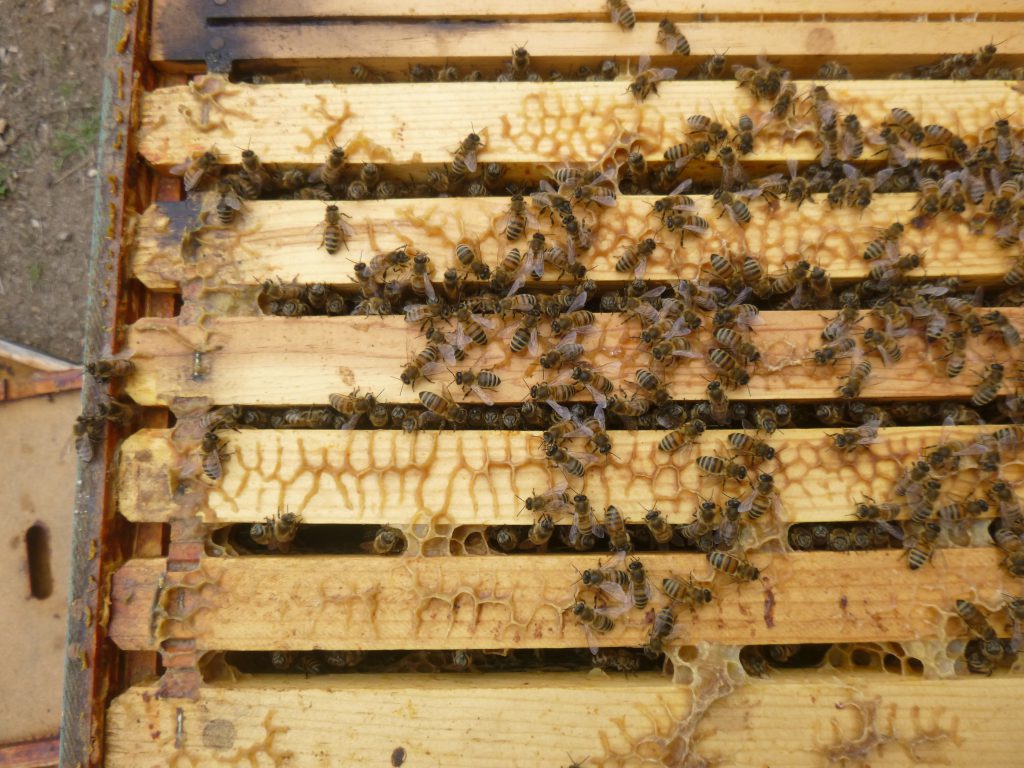
Photo credit: Tina Sebestyen
By: Tina Sebestyen
In my May article, Control Swarming Without Splitting, I mentioned the benefits of re-queening colonies in July. To quickly re-cap, colonies that receive a ripe queen cell or mated queen in mid-July enter Winter with a cluster that has 3,000 more fat Winter bees, and similarly lower numbers of Summer bees that can’t really help heat the cluster or feed larvae. Also, colonies that get a new queen in July have queens that are less likely to swarm the next Spring, while also building Spring populations faster than their older counterparts.
There are also negative things that happen that cause queens to fail faster, or to be less able to build colony populations well. And these negative things are what we are purposely doing to our colonies… repeatedly administering organic acids (or inorganic ones). Because we normal beekeepers don’t see the damage caused by miticides like oxalic acid, thymol and formic acid, we treat our bees, sometimes multiple times per year with these agents of destruction. All of these acids cause damage to bees. Worker bees die after 38 days in Summer anyway, but what about our queens that are supposed to last multiple years? They get hit time after time. These acids cause thinning of the cuticle of the honey bee, shortened lifespans, damage the egg-laying capability of the queen or the sperm stored inside her and damage the sperm of the developing drones.1 Not that we shouldn’t be keeping mite numbers low, but there are other ways to do it besides with repeated acid treatments (we’ll discuss this at greater length in the next article).
Today, we’ll discuss methods of introducing a new queen that are more reliable than just placing a queen cell with a candy plug and hoping for the best. A queen cage with a candy plug might be alright, if conditions are perfect. What are perfect conditions for queen acceptance? The queen is recently missing, like you removed her five hours ago, or maybe yesterday. There are no queen cells growing in the hive anywhere. There is open and capped brood in abundance. There is a nectar flow going on. The bees are not of an aggressive nature. Unless all of those conditions are perfect, allowing the bees to remove the candy and release the queen comes with risks.
The number one thing a colony of bees needs to be ready to accept a new queen is brood in the hive. It is the combination of brood pheromone and queen mandibular pheromone that makes a colony happy. If one is missing, no one is happy. This is why you need more than one colony, so that if you lose your queen, and discover it after the brood has emerged (which will usually be the case), you have a hive to donate brood from. It is almost impossible to get a colony of bees to accept a new queen without brood pheromone, no matter how long you take in releasing the queen. Buy a sheet of brood from someone if you have to!
Placing a queen in a hive inside a cage doesn’t actually provide much Queen Mandibular Pheromone, since it is passed by touch throughout the hive, and they can’t really touch her very well through the cage. And, thinking like a bee… if there is no brood pheromone, whose fault is it? Answer: it is the queen’s fault. The bees don’t make the connection that it was the old queen’s fault, and not this one. They just know… poor QMP and no brood pheromone, we ain’t happy. If there are still eggs in the hive, the bees will usually start emergency queen cells, even though there is a caged queen, since they aren’t getting a good dose of QMP from that young queen whose pheromones haven’t developed too well yet, and that they can’t really touch. It is important to be aware of the likelihood of queen cells in the hive, since the bees would always prefer to raise their own queen (even if it wasn’t their own egg) than to accept your store-bought queen. Even if the sheet of brood you gave them had only older larvae on it, they may have started with a too-old one rather than wait to see if other things are going to work out. So, before you release that queen from the cage, shake the bees off of every frame in the hive, even honey frames, so you can be sure to inspect every square inch of every frame and kill every one of the emergency cells they started.
Letting her out of the cage sooner, so that they can touch her is not the answer, either, since they still know that she isn’t theirs. They will ball and kill her (they usually heat her up so much that she cooks, rather than stinging her). They must be ready to accept her before you let her out of the cage. There should be brood in the hive, and there must not be any queen cells anywhere.

Mother and daughter queens are together on this frame, which is unusual. I normally find mine at opposite ends of the brood chamber. Photo credit: Beth Conrey
It might seem like it would go without saying that there also cannot be a queen in the hive. You need to be sure. About 10% of the time, there is not just one queen, but rather, there are two, a mother and daughter working together. So, even if you just killed or captured and removed a queen, keep looking, there might be a second one. Hone your skills of finding the queen (also described in the May article). And, there could be a virgin running around in the hive. Virgins are skinny and fast, and hard to find, even for seasoned queen-spotters. Ask yourself some questions: has it been two weeks since I was in the colony? Is there no open brood, but just a little capped brood left? Is there even a remnant of a queen cell in the center of a frame? (The bees often break down an emerged queen cell within 24 hours). Those clues all add up to the possibility that there is a virgin in there. How can you know for sure that there is no virgin in the hive? Answer: ask the bees. Place a frame of eggs or newly hatched larvae in the hive from another colony (again, see why you need at least two?) If there is a virgin, they won’t start queen cells, if there isn’t one, they usually will.
Now that you have removed the old queen, and searched for a potential second one, or you have asked the bees if there is a virgin in the hive, and there is brood pheromone, you are ready to begin introducing a new queen. Step one is to remove the attendants from the queen cage. I know
… the books say that you can leave them, but I learned beekeeping from wise old guys who knew that the bees in that cage aren’t always nurse bees. Sometimes, they are just five random bees, some of whom might be foragers, and who the house bees in your hive will really want to kill, placing your queen in jeopardy as well.
Here are some tricks to help you get the attendants out without losing your queen. If you are lucky enough to have all of your bees in your own backyard, the bathroom is the perfect place to do this, especially if your bathroom doesn’t have any windows in it. If it is completely dark, take your queen cage and a red headlamp in the bathroom, put the plug in the sink, pull back the screen on the face of the cage and dump all of the bees out into the sink. Bees can’t see red, so they won’t fly, they will just walk around in the sink, so you can pick your queen up (without touching her abdomen!), put her back in the cage, push the screen back in place while you can see that you are not crushing the queen anywhere, and snicker about how your family will appreciate the rest of the bees that are now loose in the bathroom.

When searching for a queen to remove her, first look at the pattern of bees on the tops of the frames. She will be in the center, under this five inch circle of concentrated bees.
I usually wait until I am in my apiary (an hour from home) so I can be sure that I still need to introduce the queen. By the time one shows up by FedEx, something might have changed, and a queen in a cage without attendants won’t live long at all, so I don’t remove them while I am still at home. Sit down with your veil in your lap, and hands and queen cage inside the veil. When bees are lost, they go up and to the light, so if she gets away from you, the queen will just end up walking around on the inside of the veil, so you can catch her and put her in the cage all alone. Don’t forget to let the other bees out of the veil before you put it on!
Both of these techniques require you to be able to handle the queen without damaging her. Practice on drones until you are confident in your ability to grab them by their thoraxes (fuzzy front shoulders) without touching their abdomens. If you aim directly for those shoulders, you will often miss and get the abdomen, since the bee isn’t stationary, but has forward momentum. Timing is everything. In hunting they call it leading… aim a little ahead of where you see the target, and by the time your fingers close, the shoulders, and not the abdomen, are what are between your thumb and forefinger. I use my non-dominant hand, and don’t think I could catch a queen with my dominant hand, but you might be different. Try learning with your non-dominant hand (so you can use a marking pen in your dominant hand), and if you can’t learn to do it, use your dominant hand. Practice, practice, practice, on drones, and then on workers who can “reward” you if you grab the abdomen.
Now, there is no other queen, virgin or queen cell in the hive. There is brood, and there is a queen alone in a cage. You are ready for the next step. Leave the cork over the candy, and place the queen cage near the top of a frame that has brood on it, preferably in the bottom box. Near the top, because if it gets cold and the cluster contracts, we want the queen to be in the center of that cluster. On brood, because that is where queens should be, where QMP and brood pheromone go together, and where the cluster will be keeping it warm. I like to use a large rubber band to secure the queen to the frame. This way, I don’t have to worry about something turning or twisting as I push the frames together, and I know for sure that the bees can access the screen to feed the queen. Someone will always feed the queen, even if they are aggressive towards her (and they will be, at first).
Feeding sugar water helps the bees be happier while they are getting used to their new girl. Leave the queen in the cage for three or four days, then check to see if the bees are ready to accept her. There will be a ball of bees around the cage. If it is a single layer of bees, that is a good sign, whereas a huge ball of bees is a sign that they are still not ready. Run your finger down the face of the screen, and the bees should move easily out of your way. If any of the bees are even a little difficult to move, it is because they are biting the cage. Even one bee biting the screen spells trouble. If they all move easily, they are just there feeding the queen. The safest thing to do is to now let the bees have access to the candy. This will be a little extra insurance, since it will usually take the bees 1½ to two days to release her.
Be sure to check one more time for queen cells. Check every frame. I’ve seen queen cells on the outside honey frame. Shake the bees off or blow them around enough to really see that there really are no little queen cells in the center of a frame all covered in bees.
If you really must release the queen as soon as you are sure they are not being aggressive towards her, then be sure to remove enough frames to reach down into the hive and let her walk out onto a frame near the bottom. Queens that have not been laying are quite capable of flying. If you release her on top of the frames, she quite often will fly away. It is possible to catch a flying queen in your bare hand, just be careful not to crush her. If you miss catching her, leave the hive open and just stand back and watch. She will sometimes come back, and the scent of bees will bring her home. I once had a queen pass by the open colony twice, picking up a bigger comet of trailing bees each time she passed, before she finally landed and walked down between the frames. Even if you don’t see her come back , give it a couple of days before you check to see if she indeed returned and is laying eggs.
The reason we are going to all of this trouble to introduce the queen is that the bees can usually get through the candy in a day-and-a-half, while it will usually take three to four days before they are not aggressive towards her if she is alone in the cage, and sometimes many more days if there are attendant bees in the cage.2 When we discover that our colony is queenless, we want to hurry up and make it right. But, rushing so much that the new queen gets killed is not making it right, and is certainly not faster. Take the time needed to do it right!
Tina can be reached at bee.seeking@gmail.com, or a list of available talks can be found on her web site https://beequest.buzz/index.html
Tihelka, Erik. “Effects of synthetic and organic acaricides on honey bee health: a review.” Slovenian Veterinary Research 55.3 (2018): 114-40. https://www.researchgate.net/profile/Erik-Tihelka/publication/328200942_Effects_of_synthetic_and_organic_acaricides_on_honey_bee_health_A_review/links/5bc24d02a6fdcc2c91fb762d/Effects-of-synthetic-and-organic-acaricides-on-honey-bee-health-A-review.pdf
Mangum, Wyatt. Queen Introduction, Part 4, The Effects of Attendants, American Bee Journal, Volume 160, No. 9, Sept. 2020, pg. 957









